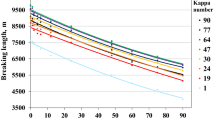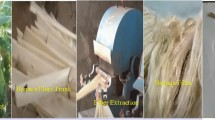Abstract
ALTHOUGH it is generally recognized that the action of far ultra-violet radiation on textile fibres is photolytic in character, investigations of the influence of oxygen and water vapour on the complex reactions involved have been mainly confined to cotton cellulose. The temperature of the system and the parameter of degradation are other factors which profoundly influence the nature of the results1. In the experiments described here we have used as parameter the loss in tensile strength of the textile yarn which was exposed to the radiations from a low pressure mercury–vapour lamp emitting mainly at 2537 Å. The yarn was contained in the inner compartment of a brass cell fitted with a quartz window. The cell was maintained at a constant temperature by circulating a suitable heating (or cooling) medium through the outer compartment. During the experiment a stream of gas brought to the required temperature was passed through the cell. For the exposures (Fig. 1) in dry oxygen and nitrogen involving temperatures down to −60° C the quartz face of the brass cell formed part of the wall of an airtight lamp chamber. At the bottom of the chamber was a tray of phosphorus pentoxide to absorb moisture and prevent the deposition of ice on the cold quartz plate. In addition a stream of dry nitrogen was passed continuously through the chamber. For the experiments (Fig. 2) with dry and moist air in which the lowest temperature was 15° C, this procedure was unnecessary and the cell was irradiated in a large well ventilated cupboard. Where dry gases were used they were dried with phosphorus pentoxide. In experiments performed in air at 100 per cent relative humidity, air was bubbled through a sintered glass filter immersed in distilled water which was maintained at the same temperature as the cell.
This is a preview of subscription content, access via your institution
Access options
Subscribe to this journal
Receive 51 print issues and online access
$199.00 per year
only $3.90 per issue
Buy this article
- Purchase on Springer Link
- Instant access to full article PDF
Prices may be subject to local taxes which are calculated during checkout
Similar content being viewed by others
References
Egerton, G. S., Nature, 194, 968 (1962).
Ford, R. A., Nature, 176, 1023 (1955); Egerton, G. S., and Fitton, S. L., Nature, 178, 41 (1956); Egerton, G. S., and Roach, A. G., Nature, 180, 189 (1957).
Moore, R. F., Polymer, 4, 493 (1963).
Author information
Authors and Affiliations
Rights and permissions
About this article
Cite this article
EGERTON, G., ATTLE, E. & RATHOR, M. Photolytic Degradation of Textile Fibres in the Far Ultra-violet. Nature 211, 1087–1088 (1966). https://doi.org/10.1038/2111087a0
Issue Date:
DOI: https://doi.org/10.1038/2111087a0
Comments
By submitting a comment you agree to abide by our Terms and Community Guidelines. If you find something abusive or that does not comply with our terms or guidelines please flag it as inappropriate.



